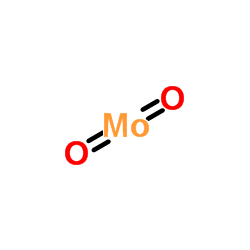Dioxomolybdenum
Modify Date: 2024-01-02 17:35:43

Dioxomolybdenum structure
|
Common Name | Dioxomolybdenum | ||
|---|---|---|---|---|
| CAS Number | 18868-43-4 | Molecular Weight | 127.939 | |
| Density | 6.47 g/mL at 25ºC(lit.) | Boiling Point | N/A | |
| Molecular Formula | MoO2 | Melting Point | N/A | |
| MSDS | Chinese USA | Flash Point | N/A | |
| Name | dioxomolybdenum |
|---|---|
| Synonym | More Synonyms |
| Density | 6.47 g/mL at 25ºC(lit.) |
|---|---|
| Molecular Formula | MoO2 |
| Molecular Weight | 127.939 |
| Exact Mass | 129.895233 |
| PSA | 34.14000 |
|
Section 1: Product Identification Chemical Name:Molybdenum (IV) oxide, 99% CAS Registry Number:18868-43-4 Formula:MoO2 EINECS Number:242-637-7 Chemical Family:metal oxide Synonym:Molybdenum dioxide, Molybdenous oxide.
Section 2: Composition and Information on Ingredients IngredientCAS NumberPercentACGIH (TWA)OSHA (PEL) Title Compound18868-43-4100%10mg/m3 (as Mo-15mg/m3 Section 3: Hazards Identification Emergency Overview:May be irritating to skin and eyes and respiratory tract. Primary Routes of Exposure:Ingestion, inhalation Eye Contact:May be a mild to severe irritant to the eyes. Skin Contact:May cause slight to mild irritation of the skin. Inhalation:Do not breath dust. Inhalation of powder may lead to irritation of the respiratory tract. Ingestion:Ingestion may lead to vomiting and diarrhea. Acute Health Affects:May be irritating to skin, eyes, mucous membranes and respiratory tract. Do not breath dust. Chronic Health Affects:No information available on long-term chronic effects. NTP:No IARC:No OSHA:No SECTION 4: First Aid Measures Immediately flush the eyes with copious amounts of water for at least 10-15 minutes. A victim may need Eye Exposure: assistance in keeping their eye lids open. Get immediate medical attention. Wash the affected area with water. Remove contaminated clothes if necessary. Seek medical assistance if Skin Exposure: irritation persists. Remove the victim to fresh air. Closely monitor the victim for signs of respiratory problems, such as difficulty Inhalation: in breathing, coughing, wheezing, or pain. In such cases seek immediate medical assistance. Seek medical attention immediately. Keep the victim calm. Give the victim water (only if conscious). Induce Ingestion: vomiting only if directed by medical personnel. SECTION 5: Fire Fighting Measures Flash Point:not applicable Autoignition Temperature:none Explosion Limits:none Extinguishing Medium:None. Material is non-flammable. Special Fire Fighting Procedures:Non-flammable. No special fire fighting procedures. Hazardous Combustion andNo hazardous combustion or decomposition products. Decomposion Products: Unusual Fire or Explosion Hazards: No unusual fire or explosion hazards. SECTION 6: Accidental Release Measures Spill and Leak Procedures:Small spills can be mixed with vermiculite or sodium carbonate and swept up. SECTION 7: Handling and Storage Handling and Storage:Store in a tightly sealed container. SECTION 8: Exposure Controls and Personal Protection Eye Protection:Always wear approved safety glasses when handling a chemical substance in the laboratory. Skin Protection:Wear appropriate chemical resistant gloves and protective clothing. Ventilation:Material may form a fine dust. If possible, handle the material in an efficient fume hood. If ventilation is not available a respirator should be worn. The use of respirators requires a Respirator Respirator: Protection Program to be in compliance with 29 CFR 1910.134. Ventilation:Material may form a fine dust. If possible, handle the material in an efficient fume hood. Additional Protection:No additional protection required. SECTION 9: Physical and Chemical Properties Color and Form:purple pwdr. Molecular Weight:127.95 Melting Point:no data Boiling Point:no data Vapor Pressure:no data Specific Gravity:6.47 Odor:none Solubility in Water:insoluble SECTION 10: Stability and Reactivity Stability:air and moisture stable solid Hazardous Polymerization:no hazardous polymerization Conditions to Avoid:none Incompatibility:none Decomposition Products:none SECTION 11: Toxicological Information RTECS Data:Subcutaneous (mouse); LD50:318 mg/kg. Carcinogenic Effects:No data available Mutagenic Effects:No data available Tetratogenic Effects:No data available SECTION 12: Ecological Information Ecological Information:No information available SECTION 13: Disposal Considerations Disposal:Dispose of according to local, state and federal regulations. SECTION 14: Transportation Shipping Name (CFR):Non-hazardous Hazard Class (CFR):NA Additional Hazard Class (CFR):NA Packaging Group (CFR):NA UN ID Number (CFR):NA Shipping Name (IATA):Non-hazardous Hazard Class (IATA):NA Additional Hazard Class (IATA):NA Packaging Group (IATA):NA UN ID Number (IATA):NA SECTION 15: Regulatory Information TSCA:Listed in the TSCA inventory. SARA (Title 313):Title compound not listed. Second Ingredient:none SECTION 16 - ADDITIONAL INFORMATION N/A |
CHEMICAL IDENTIFICATION
HEALTH HAZARD DATAACUTE TOXICITY DATA
|
| HS Code | 2825700000 |
|---|
|
A general and scalable synthesis approach to porous graphene.
Nat. Commun. 5 , 4716, (2014) Porous graphene, which features nano-scaled pores on the sheets, is mostly investigated by computational studies. The pores on the graphene sheets may contribute to the improved mass transfer and may ... |
| molybdenum dioxide |
| MoO2 |
| EINECS 242-637-9 |
| molybdenum oxide |
| Molybdenum, dioxo- |
| Molybdenum(IV) oxide |
| MFCD00014223 |
| Dioxomolybdenum |